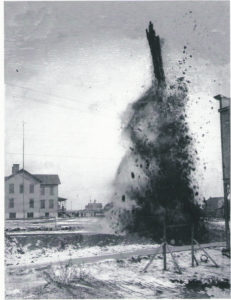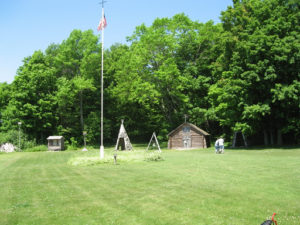The fire on Friday, September 15th, 1893, was called Manistique’s “Big Fire”. The Fire began on South Walnut Street and spread to both sides of Cedar Street. Since all the buildings except one on Cedar Street were wood, the devastation was extensive. The fire on the West Side of Cedar Street stopped only because Blumrosen’s store was brick. Due to the wind and power of the fire, the volunteer fire department fought if for five hours, trying to stop it from consuming the residential district. Had it not been for an evening rain, the entire town would been ashes. Losses from the fire were around $75,000 (several millions in today’s dollars). As a result of this fire, the city passed an ordinance saying all buildings in the downtown area were to be brick buildings.
Tag Archives: Upper Peninsula
City Council Passes Resolution To Bond For Water And Sewer
In 1905, Manistique City Council passed a resolution to bond for water and sewer. A 16-inch wooden pipe was run from Brewery Dam on the Indian River to Weston Avenue. The below picture is from November 1905 on Cedar street, showing the blasting involved to install sewer and water lines.
Originally the water supply for Manistique was from artisan wells drilled at different points within the city.
The above picture shows how wells were drilled. Water had to be hauled from the artisan wells to the homes for cooking, drinking, and washing. Several draymen hauled water to residents, hotels, and businesses. Mondays, being wash days, kept the draymen very busy.
Henry Rowe Schoolcraft-Founder Schoolcraft County
Surveys of of the Northwest Territories began in our area (Schoolcraft County) in the 1820’s, once the surveys were completed the government began handing out patents (land grants) of our territory from 1848 to 1860. Henry Rowe Schoolcraft originally came to the Great Lakes as a member of Lewis Cass’s survey expedition. The purpose of this expedition was to make topographical survey maps of Northern Michigan and the upper Great Lakes. In 1822, Schoolcraft was appointed Indian Agent with headquarters in Sault St. Marie and from 1836 to 1841 became the superintendent for the Native American affairs for Michigan. Besides being know for his writings about the manners and customs of the Chippewa Indians, his notable achievement to the government was his Treaty of March 28th, 1836, with the Native American and the Eastern half of the Upper Peninsula.
Baraga Park on Indian Lake, where (then Fr.) Baraga celebrated his first Mass
Manistique is located in the Upper Peninsula of Michigan on Lake Michigan and is the county seat for Schoolcraft County. Schoolcraft County’s orginal inhabitants were members of the Chippewa Tribes. As a result of the War of 1812, the father of Antoine Ossawinamakee was given a portion of Schoolcraft County. Their primary settlement, consisting of 10 to 12 houses, was on Indian Lake which was three miles from Manistique. In 1833, Fr Frederick Baraga established his first Native American Mission at Indian Lake and converted all but one of the inhabitants to Catholicism. Father Baraga continued his missionary work but visited the Mission Church at Indian Lake frequently. In 1853, he became the bishop of Sault St. Marie.


